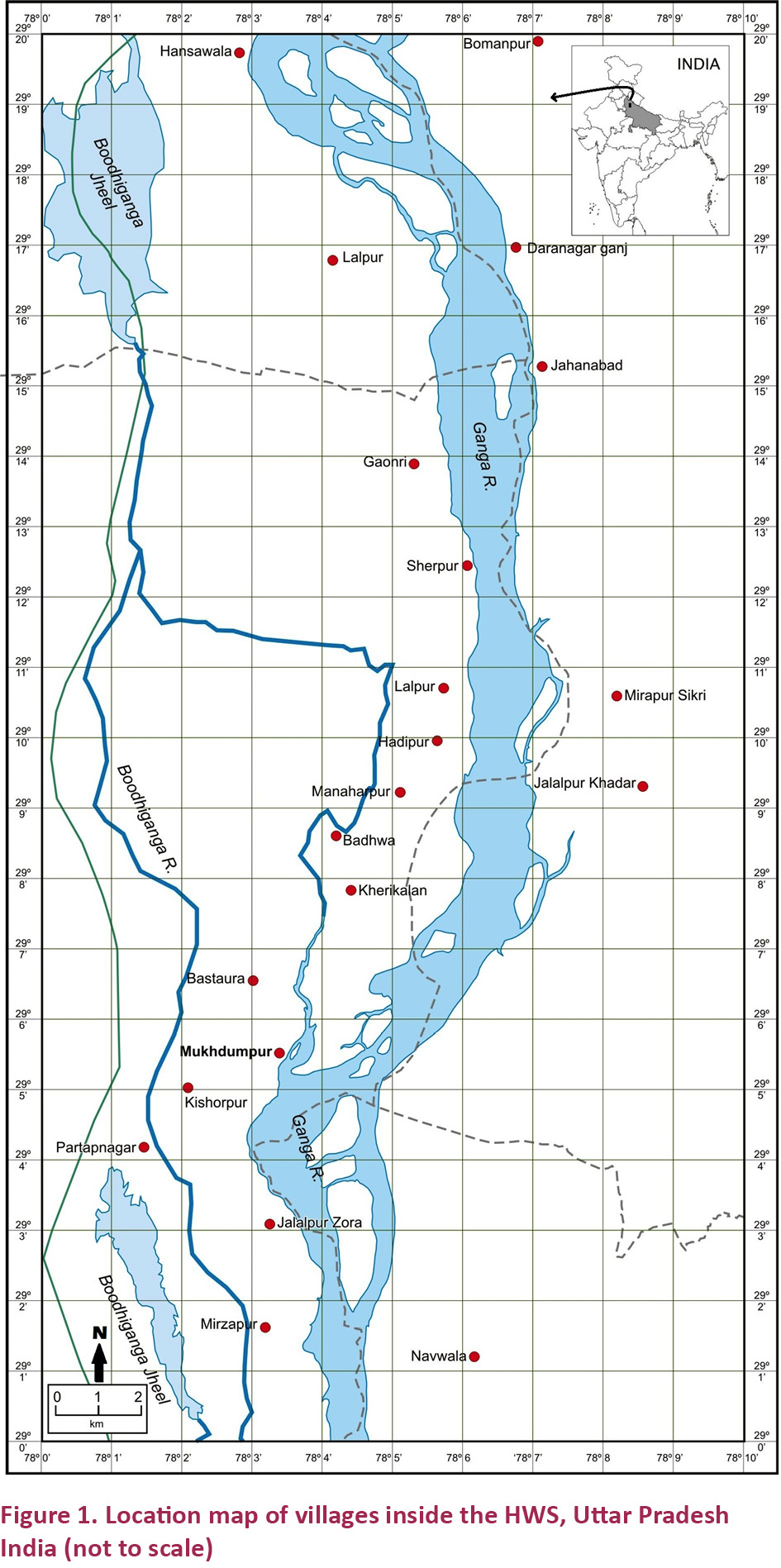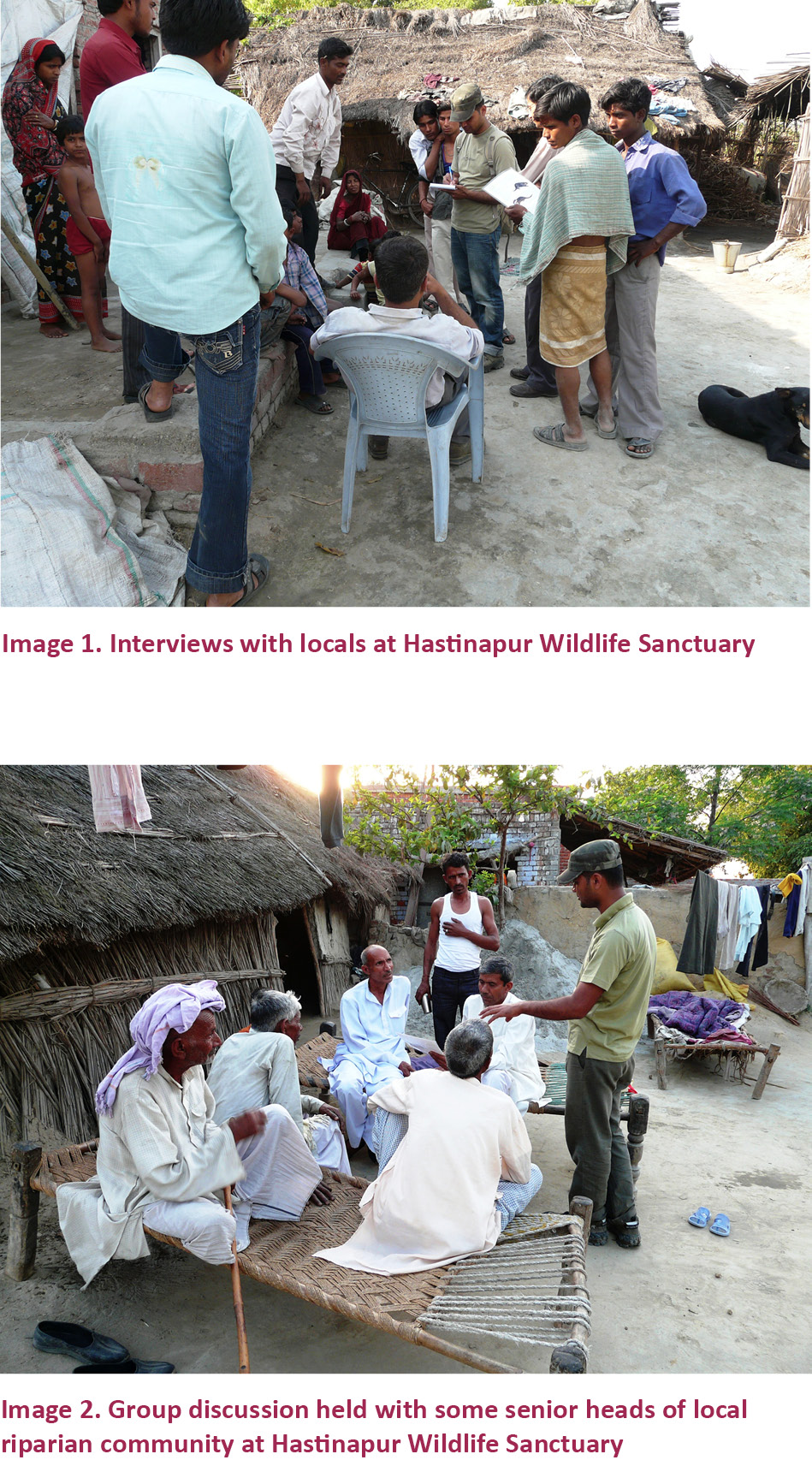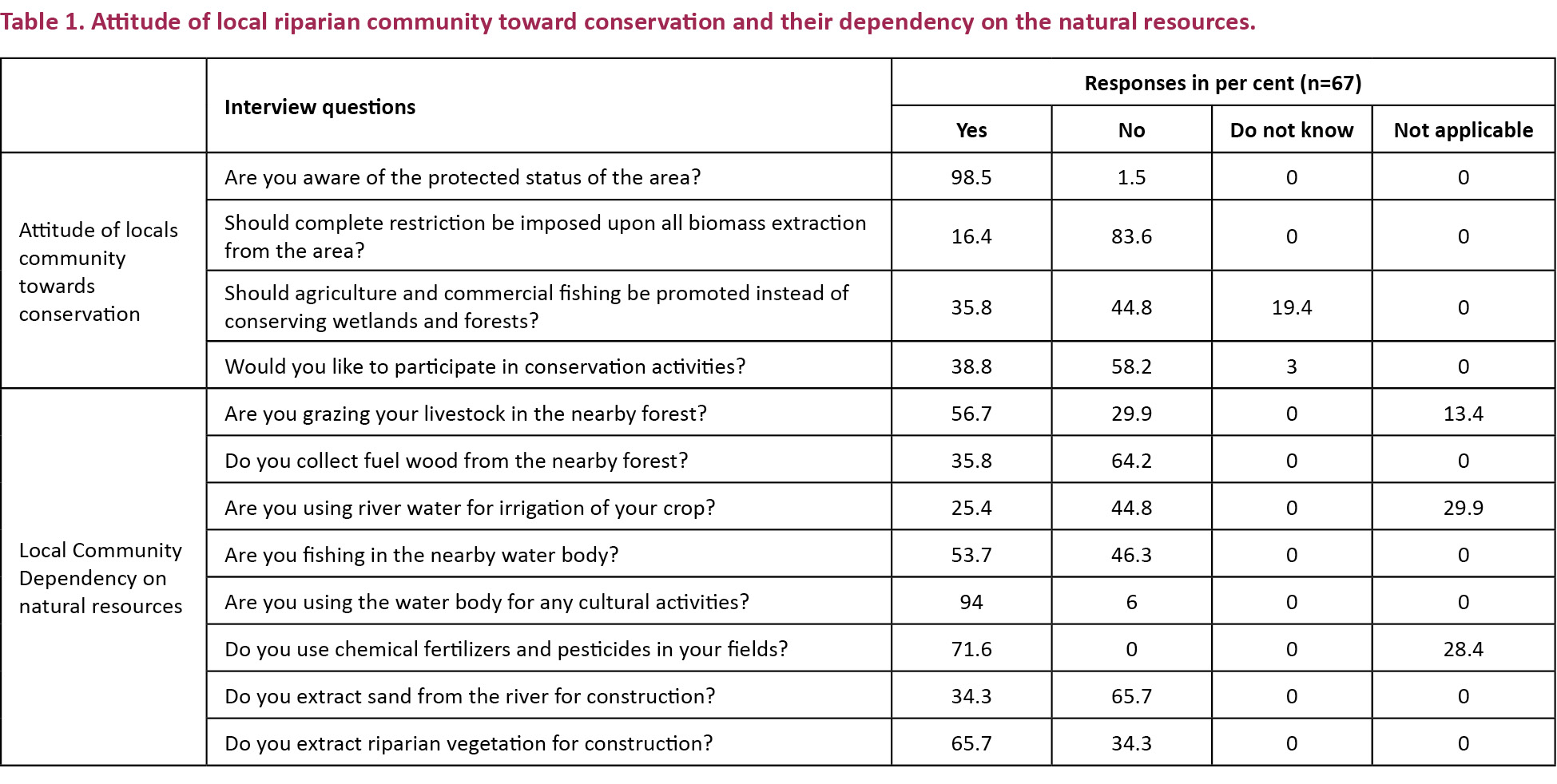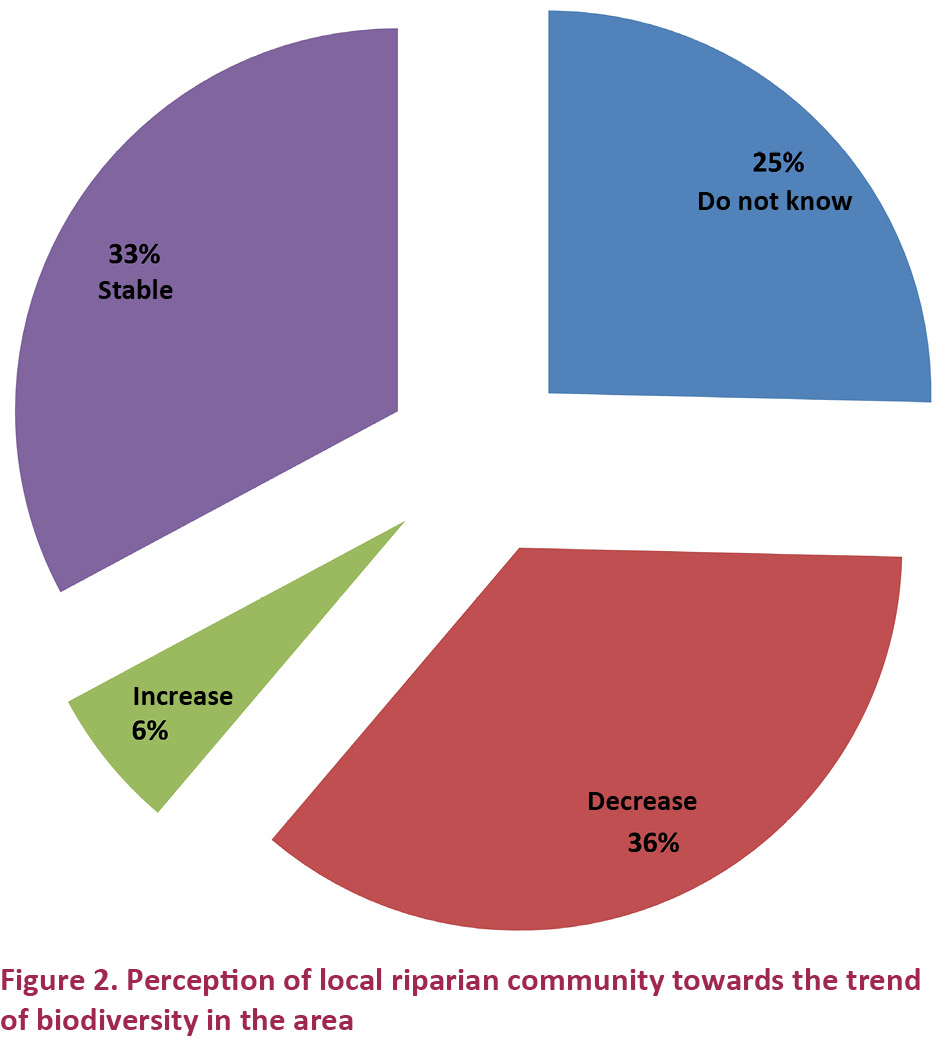How the local community views wildlife conservation: a case of Hastinapur Wildlife Sanctuary, Uttar Pradesh, India
Mohd. Shahnawaz Khan 1 & Faiza Abbasi 2
1 Freshwater and Wetlands Programme, WWF India, 172-B, Lodi Estate, New Delhi 110003 India
2 UGC Academic Staff College, Aligarh Muslim University, Aligarh, Uttar Pradesh 202002 India
1 shahnawaz.khan.aligarh@gmail.com (corresponding author), 2 faeza.abbasi@gmail.com
doi: http://dx.doi.org/10.11609/JoTT.o3943.6934-9
Editor: Hari Balasubramanian, EcoAdvisors, Nova Scotia, Canada. Date of publication: 26 February 2015 (online & print)
Manuscript details: Ms # o3943 | Received 08 February 2014 | Final received 22 December 2014 | Finally accepted 27 January 2015
Citation: Khan, M.S. & F. Abbasi (2015). How the local community views wildlife conservation: a case of Hastinapur Wildlife Sanctuary, Uttar Pradesh, India. Journal of Threatened Taxa 7(2): 6934–6939; http://dx.doi.org/10.11609/JoTT.o3943.6934-9
Copyright: © Khan & Abbasi 2015. Creative Commons Attribution 4.0 International License. JoTT allows unrestricted use of this article in any medium, reproduction and distribution by providing adequate credit to the authors and the source of publication.
Funding: Living Ganga Programme, WWF India.
Competing Interest: The authors declare no competing interests.
Acknowledgements: We thank the Department of Wildlife Sciences, Aligarh Muslim University, Aligarh for providing the logistic support and facilities necessary for carrying out the study. Authors sincerely acknowledge WWF India for providing financial support and the opportunity to first author to work in HWS, Uttar Pradesh, India. We are thankful to Mr. R. Singh (WWF India) and Dr. P. Gautam (Foundation for Ecological Security) for constant encouragement and support. We are also thankful to Dr. A. Pant (WWF India) and Dr. A. Nawab (WWF India) for their constant inspiration and cooperation at every step of this study. The help rendered by staff of WWF India’s Hastinapur field office is highly appreciated.

Abstract: A study was conducted to assess the local community’s attitudes towards wildlife conservation in Hastinapur Wildlife Sanctuary (HWS), Uttar Pradesh, India. It is the largest sanctuary in the state and under the highest anthropogenic pressure. People engage in fishing, livestock grazing, fuel wood/fodder collection, cash cropping of cucurbits in the sandy river banks for sustenance and commercial extraction of sand and grass for construction. These activities threaten the survival of threatened species like Swamp Deer Rucervus duvaucelii, Gangetic Dolphin Platanista gangetica, Smooth-coated Otter Lutrogale perspicillata and Gharial Gavialis gangeticus. Interviews were conducted with heads of randomly selected families and ‘yes/no’ opinions were taken. Questions included direct statements on biodiversity status and relationship with the Sanctuary resources. Data was classified in percent values and it was found that there is no difference in people’s perception on increase, decrease or stability of biodiversity. Further, a majority of people find life around a protected area disadvantageous, or with dismal advantages. Building on this premise the study suggests that a better share in development and alternative livelihood options for the local community of HWS can decrease their dependence on natural resources and improve conservation as a favourable option in the present perceptions of the people.
Keywords: Biodiversity, dependence, local community, perception, protected area, threatened species.
By providing the basic and essential resources to humans for their survival, rivers have been the hub for settlement of civilizations from ancient times (Clayton & Dent 1973). They have enormous cultural and economic values and are even worshipped in some religions (e.g., Hinduism). Due to the above mentioned reasons the versatile wildlife habitat along the rivers is subjected to anthropogenic pressure since the very outset of human civilization.
Being an agriculture dependent country, the economy of India is mainly governed by the yield of its agricultural farms, the majority of which are irrigated by the local irrigation canal system. The Indo-Gangetic plains are among the world’s largest and most productive flood plains covering an area of ca. 4.23 million km2 (Rodger & Panwar 1988). However the area is continuously losing its natural endowments due to habitat fragmentation, over exploitation of natural resources, pollution, weak or inadequate implementation of local conservation laws, ineffective governance and negligence by stakeholders. Very few natural wetland habitats are left in the region; some of them are protected by law, but despite being protected areas these water bodies are under a grave anthropogenic pressure. This is because the services provided by the wetlands are often undervalued (Turner et al. 2000; Ambastha et al. 2007).
The protected wetlands in South Asia possess a high biological value while sustaining high human densities, supporting local livelihoods, and facing pressures from growing commercial interests (tourism, roads, mines, dams) (Karanth & DeFries 2010). In this scenario, balancing between the conservation goals and needs of local residents is particularly challenging. These protected areas remain among the last refuges of biological diversity and have a critical role to play in minimizing species extinctions (Terborgh 1999; Joppa et al. 2008) but ignoring the social, political and economic challenges related to these areas is not realistic or viable (West et al. 2006). Understanding the attitude and perception of locals towards wildlife conservation is a fundamental need in order to balance conservation goals with the needs of local human populations (Terborgh & Peres 2002; Shahabuddin & Rangarajan 2007; Bruyere et al. 2009; Karanth & DeFries 2010).
Hastinapur Wildlife Sanctuary (HWS) is among such a few sites that harbour rare and dwindling freshwater habitat and wildlife. It is in need of instant action to check the corroding beauty. In order to reduce pressure on the natural resources of the sanctuary and to achieve the motive of sustainable conservation, the present study was carried out which quantifies the dependency of local riparian community on the natural resources of the Sanctuary and their attitude toward the protected area and its conservation.
Material and Methods
Study Area
HWS spreads over an area of 2,073km² along the banks of the river Ganges in western Uttar Pradesh. The Sanctuary was established in 1986 to conserve the fast vanishing, unique Ganga River grassland-wetland complex (Fig. 1).

River Ganga and its old bed, locally called Boodhi Ganga, forms the drainage system of the Sanctuary. The alluvial region comprises the Khola (elevated alluvial deposition, parallel to the western bank of river Ganga), Khadar (low lying sandy bed of the ever shifting river Ganga on either bank) and Boodhi Ganga (belt of swamps and marshes between Khola and Khadar, which are fed by river Ganga), a more or less permanent feature of ravines. But now marshy swamps have been or are in the process of being drained. The natural vegetation occupies only 17% of the sanctuary area and the remaining 83% is under cultivation and a township which has resulted in considerable human disturbances (Khan et al. 2013). Despite annual flooding during the monsoons in the area several villages are randomly scattered in and around the HWS along the river. The villages surveyed are well connected to the cities through road networks and most of the population live in concrete houses (houses made up of bricks) and also enjoy the facility of electricity. However municipal sewage system is not found there. The HWS holds a good variety of fauna and is specially known for supporting an isolated viable population of Swamp Deer Rucervus duvaucelii for which this protected area was established (Khan et al. 2003). In addition to this the HWS provides a place of refuge to threatened species like the Ganges River Dolphin Platanista gangetica, Gharial Gavialis gangeticus and Smooth-coated Otter Lutrogale perspicillata (Khan 2010).
Methods
A rapid survey of six villages located along the river Ganga from Bijnor barrage (29022’20.9”N & 78002’25.3”E) to Garhmukteshwar (28045’35.9”N & 78008’38.9”E) was conducted between March and May 2010 following Badola (1998), Bashir et al. (2010) and Ambastha et al. (2007). The survey was intended to assess the dependency of local riparian human communities and their attitude towards the sanctuary and its conservation. One individual of a randomly selected household, who was usually the family head, was interviewed and yes/no opinions were taken. In most instances the rest of the family members were also present and verified the statements of the interviewee by commenting and/or providing some additional information (Images 1,2). Questions included direct statements on biodiversity status and relationship with the sanctuary resources. To assess the interest and the knowledge of the interviewee about the area and the existing flora and fauna, before the interview, the individual was asked to identify local fauna especially mammals from an authentic pictorial guide (Menon 2009) and only if the respondent was found competent enough, she or he was further investigated. The village survey began with a structured questionnaire form but when the locals panicked and would have provided altered responses, we switched to informal, oral interviews based on the same format, and the questionnaire form was filled immediately after each interview to reduce errors.
Results
Of the sampled population 98.5% were found to be aware about the protected status of the area and 38.8% were found ready to help in conservation works. Of the sampled population 44.9% were found to be against the promotion of agriculture and fishing instead of wildlife conservation in the area. However, the idea of restriction on the extraction of any type of biomass from the sanctuary was not favoured by 83.6% of the sampled population. The locals were found dependent on the natural resources of the sanctuary in terms of water abstraction for agricultural irrigation (94%), shoreline vegetation extraction (65.7%), livestock grazing (56.7%), illegal fishing (53.7%), fuel wood collection (35.8%) and substrate extraction (34.3%) (Table 1). In the opinion of 36%, the density and diversity of the wildlife has decreased in the area in the last 10 years, while 33% of people thought that it had remained stable (Fig. 2). People were found to be well aware of the benefits and losses of having a wildlife protected area in the vicinity. The advantages reported were a haven of greenery and healthy environment while the disadvantages included mosquito menace, wildlife damage, lack of development and snake bites (Fig. 3). The majority of the locals had small (0.54 ha/family) or no land holding. Dependency of the locals on the sanctuary was found to be the highest in villages Zohra Jalalpur and Partapnagar as most of the residents of these villages have no land holding and the majority of these villagers were found to be dependent on the natural resources (like fish, fuel wood, fodder, vegetation for construction of houses) of the sanctuary for their living.




Discussion
The social impact of conservation on human welfare, including the compatibility of conservation and poverty alleviation and the feasibility of “win-win” strategies is a question of wider curiosity (Adams & Hutton 2007). Actions to conserve biodiversity along with the development of the local community, particularly in a sustainable way, requires sharing of knowledge of the local community and wise use of natural resources as the understanding of locals about the bio-geographical and socio-economical aspects of their immediate environment can play a significant role in designing a sustainable local policy for environmental management and conservation of its resources (Duffield et al. 1998).
Conservation in densely populated areas with high dependency on natural resources is always difficult because of the complicated decisions involved in resource allocation. Policies and measures to conserve biodiversity in such situations have ranged from policing and protection to involve the same resource dependent community in conservation and management. The efforts have met with varying degree of success with few of them having sustained (Badola & Hussain 1999). For the sustainability of conservation efforts, it is imperative that conservation be linked with mainstream economic development and the prevailing paradigm in the integration of conservation and development and vice versa (Badola 2000; Ambastha et al. 2007). The socio-economic profiling of a natural area is of use for both conservation and development decision makers. However, linking of economic benefits to conservation is difficult in the regions where many stakeholders exert high pressure on limited natural resources (Ambastha et al. 2007). A better understanding of the economic value of the natural resources permits them to be considered as economically productive alongside other uses (IUCN 2003).
Despite being aware about its protected status people were found to engage in fishing, livestock grazing, fuel wood/fodder collection, cash cropping of cucurbits in the sandy river banks for sustenance and commercial extraction of sand and grass for construction. Up to the middle of the last century, there were extensive tracts of ‘Khadar’ (low lying sandy area along both the banks of river Ganga) harbouring rich biodiversity all along the Ganga. At the time of Indo-Pak partition ‘Khadar’ received a large influx of Pakistani emigrants and about two decades back (i.e., 1980s) Punjabi emigrants settled in the area who converted the ‘Khadar’ into agricultural farms (Agarwal 2009).
Presently HWS is subjected to human disturbance, mainly due to large-scale commercial exploitation of grasses (Phragmites sp.), grazing and illegal cultivation (Khan et al. 2003). The main occupation of the locals is agriculture. The area is fertile and intensely cultivated with major crops such as sugarcane, paddy, wheat, maize and cucurbits cultivation (locally called ‘palage’) also common in the area along both the sandy banks of the river Ganga. Due to less land holding, people take up other jobs like fishing and labour during the lean period. Locals generally cultivate plants of Cucurbitaceae family on the sandy river-banks during summer. Many swamps have been drained and converted into crop fields, or have been doomed to the fate of Boodhi Ganga. Modernized farming, i.e., use of hybrid crops, unabated use of chemical fertilizers and pesticides in these agricultural fields is leading to the deteriorating water quality (Agarwal 2009). Indiscriminate fishing by use of gillnet, hooks and poison poses a major threat to aquatic fauna. Road kills and killing of injured or sick wild animals (especially deer) by feral dogs is fairly common in the areas lying on the periphery of the sanctuary (Khan 2010).
Conclusion
As the section of people interviewed at the HWS report a green and healthy environment as the only advantage of a life in and out of a wildlife protected area and many disadvantages (especially lack of participation in development), they can be wooed readily to abandoning their present occupation. Low landholding in the sanctuary area that becomes a cause for increased resource intensive activities like fishing and grass collection can actually become an incentive for embracing alternative livelihoods for the people in the villages. Increased opportunities to share the benefits of development and equitable access to an improved quality of life for the people seem to be the only long-term solution for effective conservation of the HWS. Instead of having opinions regarding the trend of area’s biodiversity over the last decade, the locals were found ignorant with almost equal (33% for increasing and 36% for decreasing) but opposite responses. A fairly high parentage (i.e., 25%) of people also admitted that they don’t know about the trend of area’s biodiversity over the last decade. Further interviews and group discussions with local heads make known that an absolute majority of people find life around a protected area disadvantageous with dismal advantages. Building on this premise the study suggests that a better share in development and alternative livelihood option to the local community of HWS can decrease their dependence and improve conservation as a favourable ground exists in the present perceptions of the people.
References
Adams, W.M. & J. Hutton ( 2007). Peoples, Parks and poverty: political ecology and biodiversity. Conservation & Society 5(2): 147–183.
Agarwal, S. (2009). Angiosperm sp. diversity and ecological assessment of Hastinapur Wildlife Sanctuary, India. PhD Thesis. Department of Botany, Aligarh Muslim University, Aligarh.
Ambastha, K., S.A. Hussain & R. Badola (2007). Social and economic considerations in conserving wetlands of Indo-Gangetic Plains: A case study of Kabartal Wetland, India. Environmentalist 27: 261–273.
Badola, R. (1998). Attitudes of local people towards conservation and alternatives to forest resources: A case study from the lower Himalayas. Biodiversity and Conservation 7: 1245–1259.
Badola, R. (2000). Local People amidst the changing conservation ethos: Relationships between people and Protected areas in India, pp. 187—204. In: Enters, T., P.B. Drust & M. Victor (eds.). Decentralization and Devolution of Forest Management in Asia and the Pacific. RECOFTC report no. 18 and RAP Publication 2000/1 Bangkok, Thailand.
Badola, R. & S.A. Hussain (1999). Collaborative management of protected areas: Approach, evolution and success, in background paper presented at the international technical consultation on protected area management and sustainable rural development- How can they reconcile. October 26–29, 1999, Harare, Zimbabwe.
Bashir, T., A. Khan, S.K. Behera & P. Gautam (2010). Socio-economic factors threating the survival of Ganges River Dolphin Platanista gangetica gangetica in the upper Ganges River, India. Journal of Threatened Taxa 2(8): 1087–1091; http://dx.doi.org/10.11609/JoTT.o2333.1087-91
Bruyere, B.L., A.W. Beh & G. Lelengula (2009). Differences in perceptions of communication, tourism benefits, and management issues in a protected area of rural Kenya. Environmental Management 43: 49–59.
Clayton, P.A. & J. Dent (1973). The Ancient River Civilizations: Western Man & the Modern World. Elsevier.
Duffield, C., J.S. Gardned, F. Berkes & R.B. Singh (1998). Local knowledge in the assessment of resource sustainability: case studies in Himachal Pradesh, India and British Columbia, Canada. Mountain Research and Development 18(1): 35–49.
IUCN (2003). Valuing wetlands in decision making: Where are we now? Integrating wetland economic values into river basin management, Wetland valuation issues paper no. 1, IUCN. Switzerland.
Joppa, L.N., S.R. Loarie & S.L. Pimm (2008).On the protection of protected areas. Proceedings of the National Academy of Sciences 105: 6673–6678.
Karanth, K.K. & R. DeFries (2010). Conservation and management in human-dominated landscapes: case studies from India. Biological Conservation 143(2): 2865–2869; http://dx.doi.org/10.1016/j.biocon.2010.05.002
Khan, J.A., A. Khan, & A.A. Khan (2003). Structure and composition of barasingha habitat in Hastinapur Wildlife Sanctuary.Wildlife Society of India, Aligarh Muslim University, Aligarh, Technical Report 14: 5–7.
Khan, M.S. (2010). Conservation status and habitat use pattern of Otters in Hastinapur Wildlife Sanctuary, Uttar Pradesh; India. MSc Dissertation. Department of Wildlife Sciences, Aligarh Muslim University, Aligarh, India.
Khan, M.S., Aftab, Z. Syed, A. Nawab, O. Ilyas & A. Khan (2013). Composition and conservation status of avian species at Hastinapur Wildlife Sanctuary,Uttar Pradesh, India. Journal of Threatened Taxa 5(12): 4714–4721; http://dx.doi.org/10.11609/JoTT.o3419.4714-21
Menon, V. (2009). Field Guide to Indian Mammals. A&C Black, London, 200pp.
Rodgers, W.A. & H.S. Panwar (1988). Planning wildlife protected area network in India - Vol. 2. Project FO: IND/82/003. FAO, Dehra Dun.
Shahabuddin, G. & M. Rangarajan (2007). Introduction. In: Shahabuddin G, Rangarajan M (eds.). Making conservation work. Permanent Black, New Delhi, 295pp.
Terborgh, J.W. (1999). Requiem for Nature. Island Press, Washington, 234pp.
Terborgh, J.W. & Peres (2002). The problem of people in parks, pp. 307–319. In: Terborgh, J.W., C. van Schaik, L. Davenport & M. Rao (eds.). Making Parks Work: Strategies for Preserving Tropical Nature. Island Press, Washington.
Turner, R.K., J.C.J.M. van den Bergh, T. Soderqvist, A. Barendregt, J. van der Straaten, E. Maltby & E.C. van Ireland (2000). The values of wetlands: landscape and institutional perspectives. Ecological Economics 35: 7–23.
West, P., J. Igor & D. Brockington (2006). Parks and peoples: the social impact of protected areas. Annual Review of Anthropology 35: 251–277.